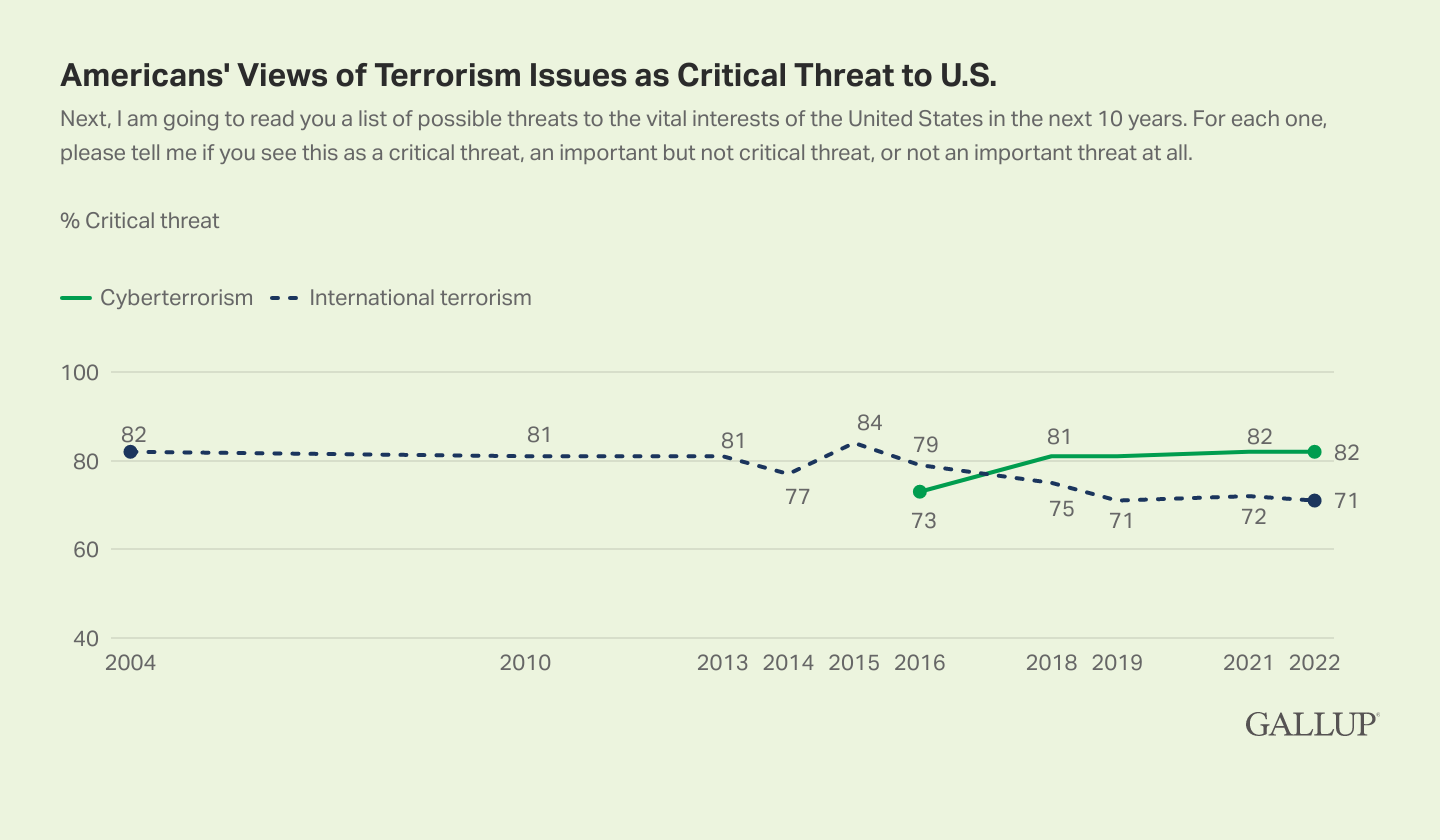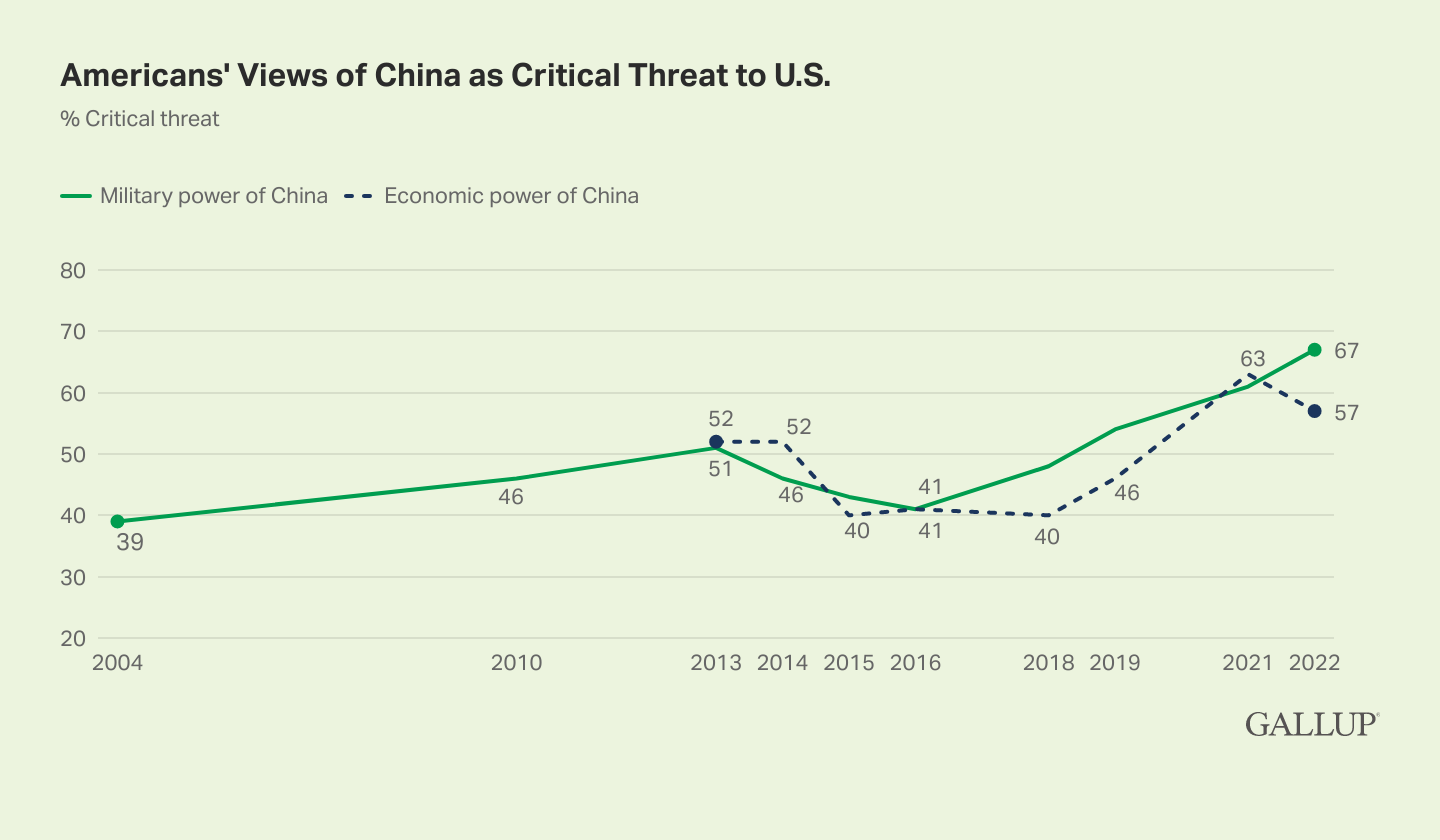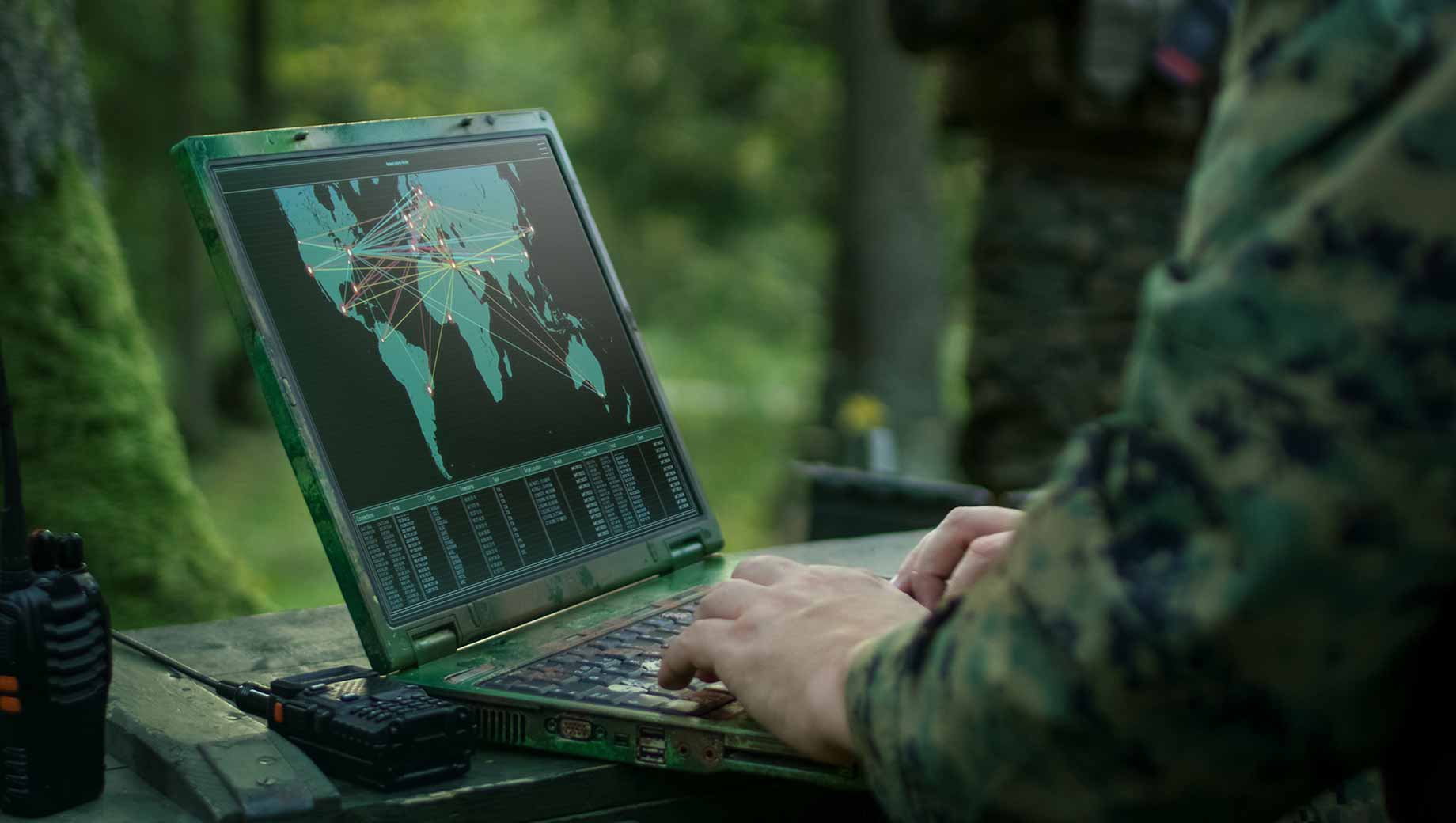Story Highlights
- 82% say cyberterrorism is critical threat
- More than three in four say Iran, North Korea nuclear weapons critical
- Surge since 2016 in seeing Chinese military as a threat
WASHINGTON, D.C. -- Americans generally regard terrorism, the development of nuclear weapons by unfriendly countries, and China's military power as the most critical threats to U.S. vital interests.
Specifically, 82% of U.S. adults identify cyberterrorism as a critical threat, while 71% say the same about international terrorism and 68% about domestic terrorism. More than three-quarters each believe Iran's and North Korea's development of nuclear weapons is a serious threat to the U.S. Two-thirds say the same about Chinese military power, while 57% identify China's economic power as a threat.
At the time of the survey, conducted in the weeks before Russia invaded Ukraine, 59% of U.S. adults regarded Russia's military power, and 52% said the Russia-Ukraine situation, represented critical threats to the U.S. As Gallup has previously reported, both measures are higher than they were in prior years.
| Critical | Important | Not important | |
|---|---|---|---|
| % | % | % | |
| Cyberterrorism, the use of computers to cause disruption or fear in society | 82 | 16 | 2 |
| Development of nuclear weapons by North Korea | 78 | 19 | 2 |
| Development of nuclear weapons by Iran | 76 | 19 | 4 |
| International terrorism | 71 | 25 | 3 |
| Domestic terrorism | 68 | 26 | 6 |
| The military power of China | 67 | 29 | 4 |
| The spread of infectious diseases throughout the world | 64 | 31 | 5 |
| The military power of Russia | 59 | 35 | 6 |
| The economic power of China | 57 | 34 | 8 |
| Global warming or climate change | 55 | 25 | 20 |
| The conflict between Russia and Ukraine | 52 | 37 | 11 |
| Large numbers of immigrants entering the United States illegally | 48 | 30 | 22 |
| The conflict between the Israelis and the Palestinians | 35 | 50 | 13 |
| Gallup, Feb. 1-17, 2022 | |||
The Feb. 1-17 Gallup poll also found that majorities of U.S. adults perceive the spread of infectious diseases throughout the world and global warming or climate change as critical threats.
China, Cyberterrorism Seen as Greater Threats Than in Past
Gallup first asked about critical threats to U.S. vital interests in 2004 and has repeated the question in most years since 2010.
Terrorism and nuclear weapons have typically been the greatest concerns. However, in recent years there has been slightly diminished concern about international terrorism and greater concern about cyberterrorism. Gallup asked about domestic terrorism for the first time this year.

Line graph. Trend in Americans' views of international terrorism and cyberterrorism as critical threats to the U.S. In 2004, 82% of U.S. adults identified international terrorism as a critical threat to the U.S. In 2015, 84% did. Since then, the percentage has been below 80%, including 71% in 2019, 72% in 2021 and 71% in 2022. In 2016, the first year the item was asked, 73% said cyberterrorism was a critical threat to the U.S. Since then, 81% or 82% have said so, including readings in 2018, 2021 and 2022.
Americans have also come to see China as a greater threat, both economically and militarily, than in the past. The 67% who currently view China's military power as a critical threat is the highest in Gallup's trend, 16 percentage points above the prior high from 2013 and 26 points higher than the previous measure, in 2016.
Gallup first asked about China's economic power in 2013, and 52% said it was a critical threat that year and in 2014. Between 2015 and 2019, Americans' opinions of the threat posed by China's economy eased, to between 40% and 46%, perhaps because Americans were more positive about the U.S. economy. However, last year the percentage viewing China's economy as a critical threat surged to 63%, before falling slightly this year, to 57%.

Line graph. Trend in Americans' views of Chinese military power and Chinese economic power as critical threats to the U.S. In 2004, 39% of U.S. adults identified the military power of China as a critical threat. Today, 67% do. In 2013, the first year it was asked, 52% said the military power of China was a critical threat. The percentage fell to 40% in 2015 and 2018, before increasing to 63% in 2021. It is 57% in 2022.
The increases in the perceived threat of China have come as Americans now view China as the United States' greatest enemy, an opinion held by 49% of respondents in the latest poll and 45% in last year's poll. Russia is second at 32% in the 2022 poll and was 26% in the 2021 poll. It is unclear how Russia's invasion of Ukraine may have changed Americans' opinions on which country is the top U.S. enemy.
In addition to shifts in the perceived threat of terrorism and China, other notable changes in Americans' views of international situations include:
-
Fewer Americans now (64%) than in 2021 (72%) say the spread of infectious diseases is a critical threat to the U.S., as COVID-19 infections and deaths have declined. The percentage saying infectious diseases are a critical threat essentially matches that of the last pre-pandemic measure, in 2016 (63%).
-
Concern about global warming has edged up slightly, from 50% in 2016 to 55% now.
-
Americans are far less likely to see the Israeli-Palestinian conflict as a critical U.S. threat now (35%) than in 2004, when 58% did.
Party Gaps Largest on Global Warming, Immigration
Republicans' and Democrats' perceptions of critical threats differ by double-digit margins on about half of the issues measured in the survey. The largest of these is for global warming, which 83% of Democrats versus 19% of Republicans regard as a critical threat to U.S. vital interests. The next-largest party gap is on illegal immigration, something 82% of Republicans and 25% of Democrats view as a major threat.
Democrats are also significantly more likely than Republicans to see the spread of infectious diseases as a critical threat. Republicans are more likely than Democrats to believe the economic power of China, Iranian nuclear weapons, the military power of China and international terrorism are threats.
| Democrat | Independent | Republican | Dem-Rep gap | |
|---|---|---|---|---|
| % | % | % | pct. pts. | |
| Global warming | 83 | 58 | 19 | +64 |
| Infectious diseases | 82 | 57 | 53 | +29 |
| Domestic terrorism | 77 | 61 | 68 | +9 |
| Russia-Ukraine conflict | 61 | 46 | 56 | +5 |
| Cyberterrorism | 84 | 80 | 84 | 0 |
| Israeli-Palestinian conflict | 36 | 30 | 42 | -6 |
| Military power of Russia | 64 | 48 | 72 | -8 |
| Nuclear weapons by North Korea | 79 | 72 | 87 | -8 |
| International terrorism | 71 | 64 | 84 | -13 |
| Military power of China | 60 | 62 | 82 | -22 |
| Nuclear weapons by Iran | 67 | 73 | 93 | -26 |
| Economic power of China | 43 | 54 | 79 | -36 |
| Immigrants entering U.S. illegally | 25 | 42 | 82 | -57 |
| Gallup, Feb. 1-17, 2022 | ||||
Independents' opinions are closer to those of Republicans on the spread of infectious diseases, while independents align more closely with Democrats on illegal immigration, China's economic and military power, Iranian nuclear weapons, and international terrorism.
Bottom Line
Among key international challenges facing the U.S., terrorism and nuclear weapons have typically stirred the most concern in Americans. Other international matters have become greater or lesser concerns, depending on how the situations are evolving. This year, as Russia was building up forces outside Ukraine's borders but before it invaded the country, more Americans than in past years saw Russia's military power and the Russia-Ukraine situation as a threat to the U.S. In recent years, as tensions between China and the U.S. have grown over trade and other matters, more Americans have also come to see China as both a critical economic and military threat to the U.S.
To stay up to date with the latest Gallup News insights and updates, follow us on Twitter.
Learn more about how the Gallup Poll Social Series works.




